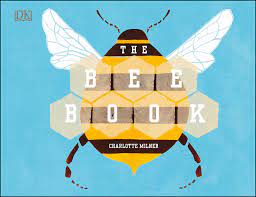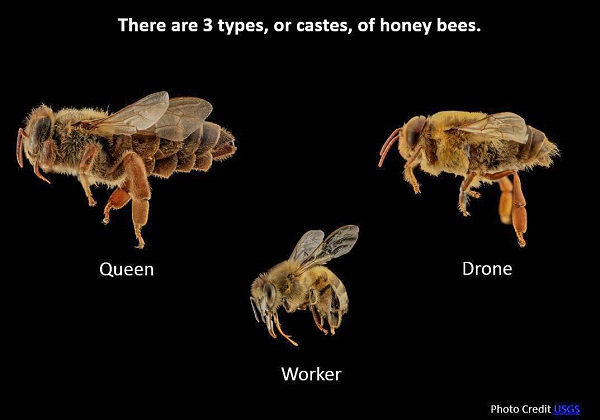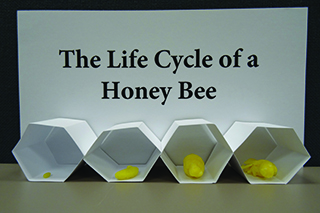 Relevancy and Engagement
dc.agclassroom.org
Relevancy and Engagement
dc.agclassroom.org
Honey Bees: A Pollination Simulation
Grade Level
Purpose
Students identify the parts of a honey bee, the stages of its life cycle, and its role in pollination. Grades 3-5
Estimated Time
Materials Needed
Engage:
- The Bee Book by Charlotte Milner
Activity 1: Bee Anatomy
- Preserved or mounted honey bee, 1 per group (If your school does not have a mounted insect collection, preserved honey bees can be found online at school and science specialty stores. Honey bees found dead outside or in window sills can also be used. If a preserved honey bee cannot be obtained, project the honey bee image from the Honey Bee PowerPoint.)
- Hand lenses, 1 per group
- Honey Bee PowerPoint Slides
- Anatomy of a Worker Bee activity sheets, 1 per student
- Anatomy of a Worker Bee Answer Key
Activity 2: Pollination Simulation
- Construction paper
- Black chenille stems, 2 per worker bee headband
- 8 containers of 100 mini (5mm) pompoms* (different colors)
- 8 small containers* of water
- 16 medium-sized (1") pompoms*
- 16 jewel bags (1.5" x 2") with yarn tied as a necklace*
- 16 drinking straws*
- Construction paper, 25 pieces
- How Do Bees Make Honey?
*These items are included in the Pollination Simulation Kit, which is available for purchase from agclassroomstore.com.
Activity 3: Beeswax Life Cycle Models
- Honey Bee PowerPoint
- Beeswax Modeling Clay Recipe
- 6 cups beeswax pellets* (available at craft stores)
- 6 tablespoons coconut oil*
- 4 tablespoons lanolin* (available at pharmacies)
- Slow cooker
- Slow cooker plastic liner
- 2-ounce plastic mini condiment cups with lids,* 1 per student or group
- Cardstock or construction paper
- Honeycomb, optional
*These items are included in the Beeswax Modeling Clay Kit, which is available for purchase from agclassroomstore.com.
Vocabulary
beeswax: a substance secreted from glands located on the underside of a worker bee’s abdomen
brood: the offspring produced by the colony (eggs and larvae)
cell: a hexagonal wax chamber built from beeswax for brood rearing and storage of honey and pollen
colony: a group living together
hive: a home to a colony of bees
honeycomb: six-sided wax cells in a beehive
metamorphosis: the process of change in the form and habits of an organism during transformation from an immature stage to an adult stage
nectar: a sweet liquid secreted by flowers
pollen: the fine, powder-like material produced by the anthers of flowering plants
pollination: the transfer of pollen from the anther to the stigma of a plant; the spreading of pollen by insects, birds, bats, and the wind between flowering plants
propolis: a resin-like material used by bees to construct and seal parts of the beehive
royal jelly: a milky, yellow syrup secreted from a gland in a young worker bee’s head; used to feed larvae
Did You Know?
- Bees pollinate 95 different crops, helping to create nearly one-third of the world's food supply.
- Honey is the only food produced by insects that is eaten by humans on a wide scale.
- A queen bee can lay over one million eggs in her lifetime.
- Worker bees' wings can beat 250 times per second allowing the bee to fly at speeds of up to 15 miles per hour.
Background Agricultural Connections
Honey bees are extremely important to humans. Bees are pollinators. They collect pollen and nectar from flowering trees and plants and transfer pollen from flower to flower. Bees pollinate 95 different crops, helping to create nearly one-third of the world’s food supply. Honey bees use the nectar they gather from flowers to make honey, which is the only commercial food produced by insects that is eaten by humans on a wide scale. Honey bees also produce beeswax, which is used to make candles, artists’ materials, lubricants, polishes, and cosmetics. Bee venom, pollen, royal jelly, and propolis are other bee-made products used in manufacturing, and for nutritional and medical purposes.
Honey bees live in large groups called colonies. There are three types, or castes, of honey bees—queen, worker, and drone.
The queen bee is a female that lays eggs. Each colony has only one queen bee. The queen can live up to four years and can lay over one million eggs in her lifetime. She can lay close to one egg per minute and between 1,000-2,000 eggs a day.
Worker bees are female bees who perform many of the jobs for the colony, including feeding the larvae; cleaning the hive; creating wax and using it to make new cells; grooming and feeding the queen; guarding and protecting the hive; and leaving the hive to collect pollen, nectar, and water. Worker bees live for about six weeks in the summer and longer in the winter months when they are less active.
Drones are male bees responsible only for mating with the queen. They do not work. There are about 100 drones in each colony. They live for about eight weeks in the summer, and are then expelled from the colony and die in the fall.
The size of a honey bee’s body depends on its caste and the task it performs. The queen bee is the largest, and the worker bee is the smallest. Honey bees, like all insects, have three main body regions—head, thorax, and abdomen.
The head contains two compound eyes, three simple eyes, two antennae, mandibles, and the proboscis. The compound eyes are made up of thousands of tiny lenses that allow the bee to see ultraviolet light (invisible to the human eye) and all colors of visible light except red. The simple eyes each have a thick lens that can sense changes in brightness. The honey bee’s antennae are movable feelers that detect smells and movement. The proboscis is a straw-like tongue used to suck nectar or honey. Mandibles are jaw-like structures used to knead wax and to chew honey and pollen.
The thorax is the honey bee’s middle region containing the flight muscles, four wings, and six legs. Honey bees have two hind wings and two forewings that can beat 250 times per second allowing the bee to fly at speeds of up to 15 miles per hour. They have three pairs of segmented legs used for walking, dusting their antennae, brushing pollen off body hairs, and storing pollen. The hind legs of worker bees contain a pollen basket—a collection of hairs where pollen is stored for transport.
The abdomen is the rear region that contains organs for digestion, reproduction, and respiration as well as the stinger and wax glands. The stinger is only found in female honey bees. A worker bee’s barbed stinger is used for defense. When stinging, the barb anchors the stinger in the victim while the stinger’s pouch pumps venom. After stinging, the bee dies of an abdominal rupture. When stinging insects, the bee’s stinger remains attached while the barb tears through the target’s exoskeleton. The honey sac is a stomach-like organ connected to the digestive tract. It is also known as the honey sack or honey stomach. The sac stores the nectar until the bee returns to the hive. Wax glands are located on the underside of the bee’s abdomen. These glands form and excrete wax.
Honey bees have four distinct life stages—egg, larva, pupa, and adult. Complete metamorphosis takes between 16 and 24 days.
The queen lays each egg into a different cell of the honeycomb. It is her job to determine whether the egg will grow into a male or female bee. Fertilized eggs will become female workers, and unfertilized eggs will become male drones. After three days, the egg hatches and a worm-like creature, called larva, is unveiled. Worker bees feed the larva royal jelly—a milky, yellow syrup secreted from a gland in the worker bee’s head. As it grows, the larva sheds its skin four to five times. On about day nine, the larva spins itself a cocoon. A worker bee seals the cocoon into the cell with wax.
Inside the cocoon, the larva transforms into a pupa—developing eyes, legs, and wings. When the bee is fully grown, it chews its way out of the cell and emerges as an adult. It takes 16 days for a queen bee to develop from an egg to an adult; worker bees take 18-22 days, and drones need 24 days.
Engage
- Ask the students, "Why are honey bees important to humans?"
- Read the folowing sections of The Bee Book by Charlotte Milner to discuss ways in which honey bees are important to humans:
- We love honeybees, and we love honey (pp.10-11)
- Why do we need pollination? (pp.20-21)
- What would we do without bees? (pp.38-39)
- Why do we need to help the bees? (pp.40-41)
- Explain to the students that they will be learning more about honey bees and pollination in this lesson.

Explore and Explain
Activity 1: Bee Anatomy
- Create groups of 4-5 students. Provide each group with hand lenses and preserved honey bees. Ask the students to examine the bees and, as a group, make a chart listing the details they observed. Provide time for each group to present their observations to the class.
- Explain to the students that honey bees have three main body regions—the head, thorax, and abdomen. Use the Honey Bee PowerPoint Slides to discuss the main parts of a worker bee.
- Ask the students to label the parts of a worker bee on the Anatomy of a Worker Bee activity sheet.
Activity 2: Pollination Simulation
- Using the background information as a guide, discuss the roles of each of the three castes of honey bees—the queen, workers, and drones.

- Simulate the role worker bees play in pollination by conducting a pollination simulation. Choose 8 students to represent flowers, 16 students to represent worker bees, and 1 student to represent the queen bee. The number of flowers and worker bees may vary according to class size. Extra students can represent the worker bees and drones that remain in the hive.
- Have the students create construction paper headbands to differentiate flowers, worker bees, and the queen bee. Draw and cut out flowers to glue onto the flower headbands. Create antennae using chenille stems to staple onto the worker bee headbands. Cut out a crown-shaped headband for the queen bee.
- Choose a large area, preferably outdoors, to serve as the “garden” and a smaller area to the side of the garden to serve as the “beehive.”
- Each flower will hold one container of mini pompoms (a different color for each flower) to represent pollen and one container of water to represent nectar. The flowers will choose a location inside the garden in which to stand.
- Each worker bee will carry one medium-sized pompom to represent the bee’s hairy body, one jewel bag tied with yarn and worn as a necklace to represent the honey sac, and one straw to represent the proboscis.
- The worker bees will begin at the beehive with the queen, drones, and other workers whose duties require them to work inside the hive. When the queen bee gives the command, the worker bees will leave the hive in search of nectar from flowers.
- When a worker finds a flower, they will land their medium-sized pompom into the container of mini pompoms. The worker will then simulate gathering nectar with their proboscis by filling a straw with water using their finger to create a vacuum. The water will be deposited into the jewel bag. When the worker removes the medium-sized pompom from the container, the tiny pompoms will stick to the larger pompom much the same way pollen sticks to the hairs of a bee when it visits a flower.
- After collecting nectar and pollen from the flower, the worker will find a new flower to visit. Here, the worker will brush off some of the pollen collected from the previous flower into the new flower’s container. They will then collect more nectar and pollen before visiting another flower.
- For the purpose of this simulation, the worker bee must collect nectar and pollen from each flower before visiting a flower for a second time, and only two bees may visit the same flower at once.
- Once the worker bee has filled their honey sac with nectar, they will return to the hive.
- Lead a discussion about what the students observed during the simulation. Did the flowers end with the same color of pollen they started with?
- Ask the students, "How do the bees use the nectar to make honey?"
- Show the video How Do Bees Make Honey? to find out how bees turn the nectar from flowers into honey and see how the flowers benefit from bees. Clarify that the honey sac can also be called the honey stomach, the term used in this video.
- Trade roles and repeat the simulation as many times as desired.
Activity 3: Beeswax Life Cycle Models
- Ask the students if humans use any items made by honey bees.
- Talk about how honey bees make beeswax. Explain that beeswax is secreted from the wax glands of worker bees to create and cap cells inside the hive. Beeswax is used in the production of candles, cosmetics, artists’ materials, electronics, lubricants, polishes, inks, and paints. Bees require the protein from pollen and the carbohydrates from honey to create beeswax. It takes 6-10 pounds of honey to make one pound of wax, which is enough to construct 35,000 cells within a hive. A beekeeper will harvest two pounds of wax cappings for every 100 pounds of honey.
- If possible, obtain honeycomb so students can observe the wax cells and cappings. Honey in the comb can be obtained from beekeepers, specialty stores, online stores, and farmers markets.
- Use the Honey Bee PowerPoint to discuss the life cycle of a honey bee.
- View the Amazing Time-Lapse: Bees Hatch Before Your Eyes video to watch the growth of larvae into bees.
- Use the Beeswax Modeling Clay Recipe to make beeswax modeling clay. Instruct the students to use the clay to create a honey bee life cycle model by creating an egg, larva, pupa, and adult honey bee. Refer to the Honey Bee PowerPoint for photographs of each life stage. Students can work in groups or individually to create their life cycle model.
- A cell for each life stage can be created out of paper folded into the shape of a hexagon.

Elaborate
- View the Beekeeping with Maddie (8:47) video to learn more about how backyard beekeepers harvest honey.
-
The Harvard Microrobotics Lab breaks down the mechanics of insect flight to create a biologically-inspired insect-scaled robot, shown in this two-minute video, Tiny, Robotic Bees Could Change the World.
-
Have the students use the instructions from the Draw a Bee video by the illustrator and author of The Bee Book, Charlotte Miner to draw a honey bee.
Evaluate
After conducting these activities, review and summarize the following key concepts:
- Bees are important to humans because they pollinate crops that produce our food.
- A colony of bees is very organized with specific workers for individual jobs.
- There are four stages in the life cycle of a honey bee—egg, larva, pupa, and adult.
- Honey bees use the nectar they gather from flowers to make honey.
- Honey bees also produce beeswax.
Recommended Companion Resources
- Achoo! Why Pollen Counts
- AgBadging Field Guide
- Akeem Keeps Bees!: A Close-Up Look at the Honey Makers and Pollinators of Sankofa Farms
- Amazing Time-Lapse: Bees Hatch Before Your Eyes
- Anatomy of a Worker Bee
- Beebuzz
- Beekeepers
- Bees and Wasps
- Beeswax Lip Balm Kit
- Beeswax Modeling Clay Kit
- Before the Plate Website
- Buzzing With Questions: The Inquisitive Mind of Charles Henry Turner
- Flight of the Honey Bee
- Flower Talk: How Plants Use Color to Communicate
- Give Bees a Chance
- Henry Meets a Honey Bee
- Honey Bee Study Prints
- Honeybee
- How Do Apples Grow?
- How It's Made: Honey
- In the Trees, Honey Bees
- Introduction to Pollination Video
- Meadowscaping Makes it Better Activity Guide
- Meadowscaping with Kids
- NMSU Field Trip: Honey
- Pollen: Darwin's 130 Year Prediction
- Pollination Simulation Kit
- Prolific Pollinators
- That's So Sweet! – A Look at Honey Production in the Twin Cities
- The Bee Book
- The Bee Tree
- The Beeman
- The Big Soap-rise (Farm Friends)
- The Honey Files
- The Honeybee Man
- The Honeybee and the Robber
- The Importance of Pollinators
- The Life and Times of the Honeybee
- The Thing About Bees: A Love Letter
- UnBEElievables
- Up Close Experience: Bees
- Utah State University Bee Lab
- When the Bees Fly Home
- Wings of Life